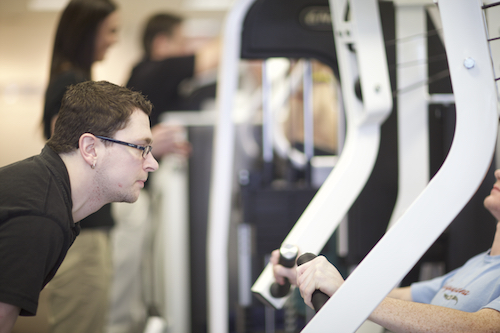February is Heart Health Month – Strength Training is Cardio
February is Heart Health month, and I’m not talking about candy hearts. What many people don’t realize is that strength and resistance training can be a form of cardio, which can help improve your heart health. You have to maintain a certain heart rate while going through your workout by taking minimal breaks between exercises.
Cardiovascular Health
Exercise is the act of creating change in your body by imposing a form of stress. Therefore, strength training causes your heart to work harder, which strengthens it just like any other muscle. As you increase your level of activity and stress on your muscles, your body will adapt and allow you to do more work in the future. When you improve your cardiovascular function you actually create multiple physiological benefits in the heart, the circulatory system, and the blood. According to Wayne Westcott, PhD, “Endurance exercise increases your heart’s stroke volume and decreases your heart rate, making your heart a stronger pump. A greater stroke volume enables your heart to pump more blood every time it beats. A slower heart rate allows your heart to rest longer and to fill more completely with blood between beats.” (Westcott, Building Strength and Stamina, pgs. 147-148).
Eventually, performing regular high-intensity strength training will allow you to achieve a reduced resting heart rate. This is achieved by triggering a physiological response in your heart, making it stronger. It is therefore possible to decrease your heart rate from an average 75 beats per minute to 55 beats per minute. This saves 30,000 beats worth of wear and tear on your heart per day.
The Definition of Cardio Exercise
Too many people think that walking your dog is exercise. If it isn’t producing a stress, walking isn’t exercise, it’s just transportation. As any other muscle, your heart can’t change if it isn’t exposed to stress.
According to Doug McGuff M.D., “Exercise is a specific activity that stimulates a positive physiological adaptation that serves to enhance fitness and health and does not undermine the latter in the process of enhancing the former.” (McGuff, Body by Science, pg. 2). What this means is that if you hurt yourself through overstrain while exercising, you are sacrificing your health in order to enhance your fitness. However, if you don’t provide enough stress to trigger a physiological adaptation, you aren’t enhancing your fitness.
In order to trigger a physiological adaptation in your heart muscle during strength training, it is important to keep a constant pace during your workout with few breaks between exercises, and to perform each exercise to maximum effort. This will keep your heart rate in its cardiovascular target zone.
Fringe Cardio Health Benefits
Not only your heart itself receives the benefits of improved cardiovascular health, but your entire circulatory system will see improvements. For example, Wayne Westcott cites improvements to circulatory efficiency: “Your circulatory system responds to endurance exercise by becoming more efficient. The blood vessels also increase in size, number, and tone. Larger blood vessels carry more blood to the working muscles, including the heart. More blood vessels distribute blood better within the working muscles, including the heart. Toned blood vessels respond to your body’s physical demands better, reducing blood flow to inactive areas and increasing blood flow to the working muscles as needed. These circulatory system changes may reduce resting blood pressure and enhance cardio-vascular function.” (Westcott, Building Strength and Stamina, pg. 148)
While your muscles require your blood, your heart will work harder. Therefore, strength training is a form of cardiovascular and endurance exercise.
Request a complimentary first session at Vertex Fitness, Voted the BEST Personal Training Studio on the Main Line
Click HERE and we will schedule a session to try it yourself
Complimentary First Workout Session










Leave a Comment